Awareness and attitudes towards the revised National Cervical Screening Program amongst women in rural New South Wales: a cross-sectional study
Elizabeth Gosbell A # , Alisha Panambalana A # , Annabelle Stephenson A # , Carissa Vici A # , Tegan Dutton A and Jannine Bailey
A and Jannine Bailey  A *
A *
A Bathurst Rural Clinical School, School of Medicine, Western Sydney University, Bathurst, NSW 2795, Australia.
Australian Journal of Primary Health 29(5) 471-479 https://doi.org/10.1071/PY22267
Submitted: 8 December 2022 Accepted: 6 March 2023 Published: 11 April 2023
© 2023 The Author(s) (or their employer(s)). Published by CSIRO Publishing on behalf of La Trobe University. This is an open access article distributed under the Creative Commons Attribution-NonCommercial-NoDerivatives 4.0 International License (CC BY-NC-ND)
Abstract
Background: Research exploring awareness and attitudes towards the revised National Cervical Screening Program (NCSP) amongst rural Australian women is limited. Given the increased incidence and mortality from cervical cancer in rural Australian women, this gap needs attention. This study examined awareness and attitudes of women in rural New South Wales (NSW) towards the revised NCSP.
Methods: A cross-sectional survey was conducted with women aged 18–74 years currently residing in the Western NSW Primary Health Network region. The anonymous survey was distributed online via social media and email to eligible women.
Results: In total, 309 rural women participated. The majority were 30–39 years old (35.9%) and had completed tertiary education (73.1%), figures which are higher than average for this rural region. Of these, 51.8% (160/309) were aware there had been a change to the NCSP. This information most commonly came from their healthcare provider (57.5%; 82/160). Three-quarters reported being happy or neutral with the change (76.1%; 235/309). Those who were aware of the revised NCSP were more likely to have a positive attitude toward it (P = 0.02). Fewer participants reported that they were never/unlikely to participate in screening under the revised NCSP (4.8%, 9/309) as compared to the previous program (15.5%, 48/309) after being provided with information about the revised NCSP. Women who reported an abnormal result under the previous NCSP were more likely to be concerned about the revised NCSP (P = 0.037), in particular the starting age of 25 years (P = 0.007) and the 5-yearly screening interval (P = 0.008).
Conclusion: Awareness and knowledge levels play an important role in attitudes towards the revised NCSP in rural women. Strategies to increase participation rates should therefore target these areas. Healthcare professionals can take a central role in this information sharing process.
Keywords: awareness, cancer, cervical, human papillomavirus, knowledge, prevention, rural and remote, screening, women.
Introduction
In 2017, the National Cervical Screening Program (NCSP) was revised and the traditional Papanicolaou (Pap) test was replaced with the Cervical Screening Test (CST; Australian Government Department of Health and Aged Care 2022). Instead of detecting abnormal cells, the CST detects the presence of Human Papillomavirus (HPV; Australian Government Department of Health and Aged Care 2022). The revised program starts at 25 years of age and screening is recommended every 5 years. This is because persistent HPV infection typically takes 10–15 years to develop into cervical cancer. Hence the CST allows for less frequent screening and can be started at a later age. It is predicted that by 2035, the change to the CST will result in a decrease in cervical cancer incidence and mortality, with 2006 cases of invasive cervical cancer and 587 deaths averted between 2018 and 2035 (Hall et al. 2018).
Current literature has identified negative attitudes and barriers to accepting the revised NCSP among Australian women (McRae et al. 2014; O’Connor et al. 2014; Jayasinghe et al. 2016; Yap et al. 2016; Obermair et al. 2018; Patel et al. 2018; Clay et al. 2019; Smith et al. 2019; Nagendiram et al. 2020a, 2020b). The most significant are lack of knowledge and education on cervical cancer and HPV (McRae et al. 2014; O’Connor et al. 2014; Clay et al. 2019; Dodd et al. 2019; Nagendiram et al. 2020a, 2020b). Chief issues voiced by both women and clinicians regarding the change have been with delaying the start of screening from 18 to 25 years, and the increased interval between screenings (Yap et al. 2016; Obermair et al. 2018; Clay et al. 2019; Dodd et al. 2019; Smith et al. 2019). Additionally, the Pap test is regarded as being highly successful and women have expressed reluctance to change an already successful program (Obermair et al. 2018; Dodd et al. 2019), with some concerned that only testing for HPV will result in missed cervical cancer detection (McRae et al. 2014; O’Connor et al. 2014; Obermair et al. 2018; Dodd et al. 2019). Another concern is that the change has been a political decision, made by men, with the delayed onset and increased screening intervals seen as purely a cost-cutting exercise (Obermair et al. 2018). Compounding this, research has identified a general decline in Australian women’s participation in the NCSP over recent years separate to the introduction of the revised NCSP (Nagendiram et al. 2020b). Common reasons cited were lack of time, embarrassment, fear of the results and not wanting to be seen by male health professionals (Nagendiram et al. 2020b). Thus, in addition to identifying and addressing barriers to accepting the changes to the NCSP, these pre-existing barriers must also be addressed when developing strategies to increase future compliance.
Whilst existing research has identified some barriers to accepting the revised NCSP, only two qualitative studies, one conducted in North Queensland (Nagendiram et al. 2020a) and one in Victoria (Azar et al. 2022), have specifically assessed the attitudes of rural women. Rural women in North Queensland were hesitant about the revised NSCP mainly because of a lack of knowledge about why the changes were taking place, and with extra knowledge these women were much more accepting of the changes (Nagendiram et al. 2020a). In rural Victoria, women identified similar barriers to those reported earlier for the wider Australian population (Azar et al. 2022). Multiple calls to action from their general practitioner, coupled with social media marketing campaigns, were identified as key avenues to helping them understand the importance of preventative screening and to prompt them to undertake screening (Azar et al. 2022).
National data show that the incidence of cervical cancer in women aged 20–69 is higher in regional/remote areas (10.3–12.2 new cases per 100 000 women) compared to major cities (9.3 new cases per 100 000 women; Australian Institute of Health and Welfare 2019). Additionally, in women aged 20–69, mortality due to cervical cancer is higher in regional/remote areas (1.8–2.8 deaths per 100 000 women) compared with major cities (1.7 deaths per 100 000 women; Australian Institute of Health and Welfare 2019). The increased incidence and mortality of cervical cancer in rural and remote women highlights the importance of increasing their participation in the NCSP.
There is a paucity of quantitative data on the awareness and attitudes of rural women from New South Wales (NSW) to the revised NCSP, and indeed from rural Australian women more broadly. There is therefore a need for further research to shed light on the factors associated with satisfaction with the program so that health promotion strategies can be devised to increase screening participation. This study sought to explore the awareness and attitudes of women in rural NSW towards the revised NCSP. The primary research questions were:
-
What is the level of awareness amongst women in rural NSW regarding the revised NCSP?
-
What are the attitudes of these women towards the revised NCSP?
-
What barriers to participation do they identify regarding the revised NCSP?
Methods
Study design and setting
This cross-sectional study was conducted in the Western NSW Primary Health Network region, which encompasses both the Western and Far West Local Health Districts. An anonymous online survey, comprising a mix of multiple-choice questions, Likert scale responses and short answer responses, was distributed in the study region between July and September 2020.
Participants and recruitment
Eligible participants were females, aged 18–74 years of age, currently residing in the study region and able to read, write and comprehend English to the extent that they could complete the survey. This age range was selected to include the attitudes of women who were eligible under both the previous NCSP guidelines (ages 18–69) and the revised NCSP guidelines (ages 25–74; Royal Australian College of General Practitioners 2021). Recruitment was conducted via social media and email. All surveys were distributed with the Participant Information Sheet being the first page of the online survey. Participant consent was implied by submission of a completed survey.
Data collection tool
The survey was hosted online on the survey platform Qualtrics (www.qualtrics.com). The survey was developed by the research team through reviewing the literature on the topic and pilot-tested on a small subset (n = 8) of the target population, who met all eligibility criteria with the exception of being rural. Their feedback was incorporated into the final version of the survey. Survey questions covered demographic information about the participants, their participation in the NCSP, their knowledge of the program and the recent changes and their attitudes towards the revised program (see the Supplementary material for the survey tool).
Data analysis
Data were downloaded as a single excel file for analysis using SPSS statistical analysis software (https://www.ibm.com/au-en/products/spss-statistics). Data were summ (Royal Australian College of General Practitioners 2021) arised using descriptive statistics. Chi-square tests were used to test for associations between demographic variables and knowledge, perspectives and attitudes towards the revised NCSP. Statistical significance was set at P < 0.05. For the statistical analyses, some categories were collapsed, including the ‘Education’ category in which the ‘Below Year 10’ and ‘Year 10 and equivalent’ responses were grouped together as ‘Year 10 and below’, due to few participants reporting ‘Below Year 10’ education level (N = 4). The overall attitudes category was collapsed with ‘Happy and Very Happy’ responses classed into the ‘Happy’ category, ‘Neutral’ remained the same, and ‘Very unhappy and Unhappy’ responses were grouped into the ‘Unhappy’ category. Free text comments were analysed using a summative content analysis approach (Hsieh and Shannon 2005). In brief, free text comments from participants were analysed to identify and interpret content relevant to the survey questions. Relevant content was assigned a code, with similar responses assigned the same code. Codes were broadly categorised into ‘happy’, ‘neutral’ or ‘unhappy’ for enumeration to determine their frequency within the participant sample (Hsieh and Shannon 2005).
Ethics approval
Ethics approval to conduct the study was obtained from the Western Sydney University Human Research Ethics Committee (Approval H1137). A full informed consent process was used for all participants.
Results
Participant demographics
A total of 309 rural women participated in the survey. Of these, the majority were in the 30–39 age group (35.9%), most had completed tertiary education (73.1%) and 40.8% self-reported they were vaccinated against the HPV virus (Table 1). Most respondents were unable to provide the year of their last cervical screen (responses provided were ‘unsure’ or ‘don’t know’) and hence we were unable to determine if respondents were up to date with screening or not.
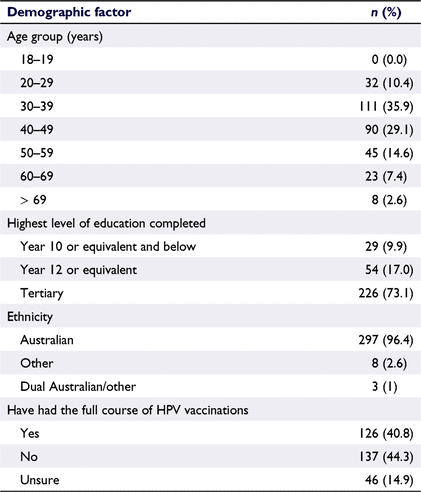
|
Women’s awareness of, and attitudes towards, the revised NCSP
Approximately half of the women were aware that there had been a change to the CST (51.8%; 160/309) and 46.3% (143/309) reported being happy with the change to the CST. Reasons given by participants for their overall attitudes are summarised in Table 2 and include concerns about the new test potentially missing cancers, the pain and awkwardness that can accompany the Pap test and being able or unable to trust the research behind the revised NCSP (Table 2). Regarding their likelihood of participating in the revised NCSP, the majority of participants reported that they definitely would participate (58.3%; 180/309); a slight increase on the 51.8% (160/309) that reported they would definitely participate in Pap testing (Table 3). Notably, fewer participants reported that they would ‘never’ or were ‘unlikely’ to participate in the CST (4.8%, 9/309) as compared to the Pap test (15.5%, 48/309; Table 3).
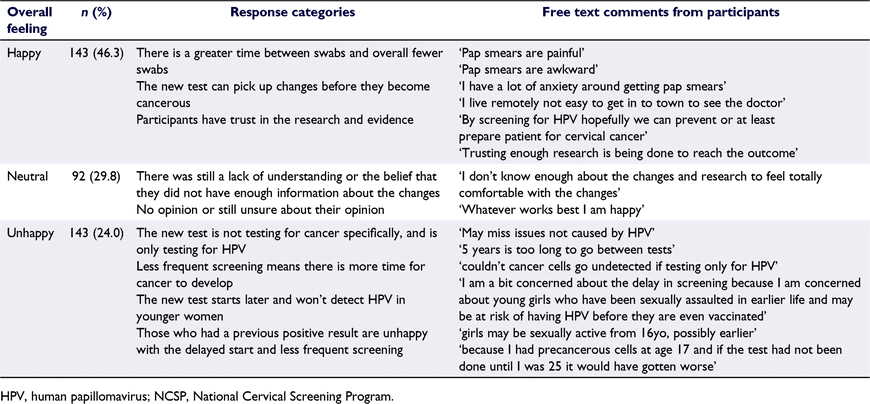
|
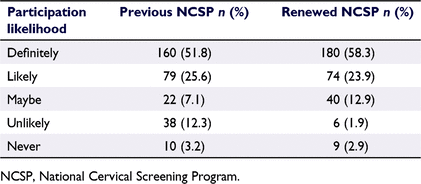
|
When asked to identify how they found out about the change to the NCSP, the two most common responses were that they found out from their healthcare provider (57.5%; 92/160) and the media (56.9%; 91/160). Other sources of information on the NCSP were work (7.5%, 12/160), word of mouth/friends (5.0%, 8/160), government (3.8%, 6/160) and unsure (1.9%, 3/160). Participants provided suggestions of potential avenues that could be utilised to inform women of the changes to the NCSP as summarised in Table 4. Personalised communication was the most popular option with 32.0% (16/50) suggesting that letters, text messages or emails are effective methods for sharing information. Notably, health services and education centres were also frequently reported (8/50;16%) as an avenue for providing information.
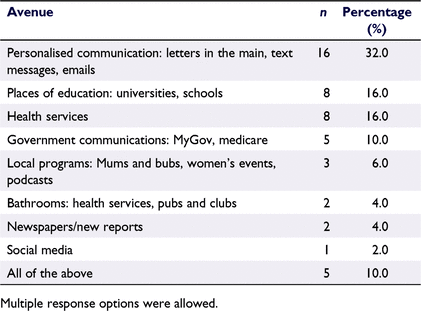
|
Association between participant demographics and awareness and attitudes toward the revised NCSP
Regarding education level (Table 5), of those who achieved Year 10 or below, 34.5% (10/29) were aware of the change in the NCSP. This is compared to 42.6% (23/54) in the Year 12 or equivalent group and 56.2% (127/2260) in the Tertiary or above group. The association between education level and awareness of the revised NCSP (P = 0.029) was statistically significant, with those of a higher education level being more likely to have awareness of the revised NCSP. A higher education level was also associated with a higher level of satisfaction with the revised NCSP (P = 0.008). No statistically significant association was found between age and level of awareness (P = 0.277) (Table 5) or age and attitudes to the revised NCSP (P = 0.206).

|
Association between awareness and attitudes to the revised NCSP
In participants that were aware of the change (160/299), 56.9% were happy with the revised NCSP. However, of participants that were unaware of the change, only 34.9% responded happy. If the participant was unaware of the changes (149/299), they were more likely to be dissatisfied or have neutral attitudes to the changes (65.1% voted neutral or unhappy as compared to 43.2% of those who were aware). There was a significant association found between awareness and attitudes (P = 0.02), where those who were more aware of the revised NCSP were more likely to have a positive attitude toward it (Table 6).
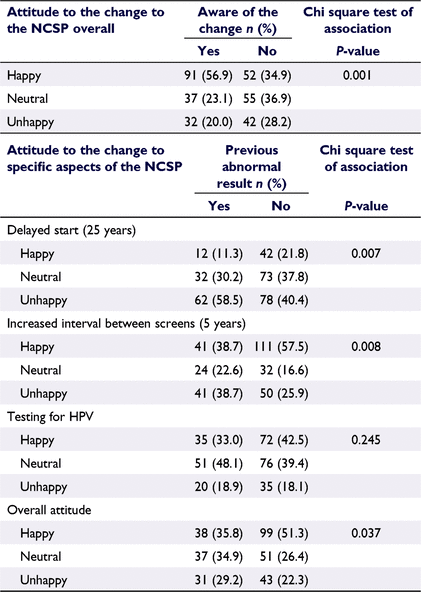
|
Influence of previous abnormal result on attitudes towards the revised NCSP
Out of participants who reported having abnormal results in the past (106/299, 35.5%), 58.5% were unhappy with a delayed start time (i.e. first screen at 25 rather than 18 years; Table 6). This is compared to participants who had not had an abnormal result (193/299; 64.5%) where only 40.4% responded with ‘Unhappy’ (P = 0.007). For participants who had an abnormal result in the past, 38.7% were unhappy with the increased interval in screening, compared to 25.9% who had never had an abnormal result. This result was statistically significant (P = 0.0008). From the participants who had not had an abnormal result in the past, 51.3% responded that they were overall ‘Happy’ with the changes and 22.3% were ‘Unhappy’. Comparatively, of those who previously had an abnormal test result, only 35.9% responded ‘Happy’ and 29.2% responded ‘Unhappy’ (P = 0.037). There was no statistically significant relationship found between previous abnormal results and attitudes towards the testing of HPV virus instead of cell changes (P = 0.245) (Table 6).
Barriers to women’s participation in the revised NCSP
Numerous barriers to participating in the revised NCSP were identified, with the most common being lack of education on the program (42.4%, 165/389) and lack of knowledge regarding cervical cancer (20.3%, 79/389). Indeed, few participants correctly identified what the old test was looking for (26.5%, 82/309) with the most common incorrect answer being ‘cervical cancer’ (Table 7). With regards to the revised NCSP, few were aware of when screening should start (6.5%, 20/309) with most incorrect answers being either 18 or 21 years old. Even fewer participants could identify when screening should stop (3.9%, 12/309), with most participants believing screening ends at 65 or 70. A few participants expressed a desire for screening to never stop. Many were also unsure of the relation between sexual activity and the commencement of screening with the revised NCSP. More participants, however, were able to identify how often screening occurs with the revised NCSP (31.1%, 96/309). Many participants chose to elaborate on their responses in this section, separating their answer into whether or not the result was normal or abnormal.
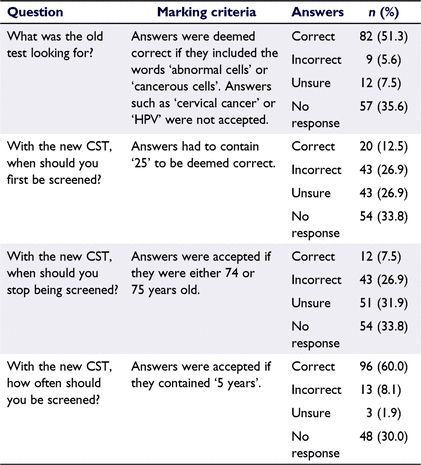
|
Table 8 details the breakdown of responses of further barriers given by participants for participating in the NCSP. Some of the most common additional barriers cited were accessibility and discomfort/pain with the procedure, albeit the majority of participants (91.7%) reported none of the provided options were barriers. Other concerns regarding the revised NCSP (Table 9) included increased time periods between screens, increased start age of screening, pain/previous negative experience and accessibility. Women also wanted to know why the test had changed, with 3.6% of participants (11/309) stating lack of information regarding this matter as a significant concern.
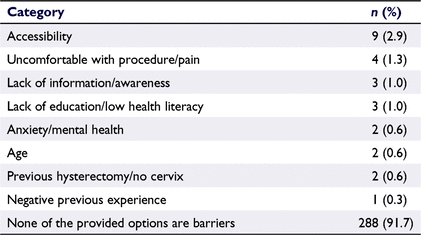
|
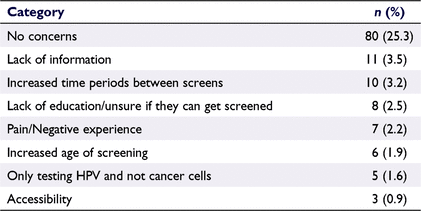
|
Discussion
This study aimed to explore awareness and attitudes of rural women towards the revised NCSP, and barriers to participation. Overall, attitudes towards the change were predominantly positive/neutral, rather than negative. However, awareness was relatively low and reported likelihood of participating in screening under the revised versus the previous program remained similar. Women who reported having had a previous abnormal result under the previous NCSP were more likely to be concerned about the revised NCSP, in particular the delayed starting age of 25 years and the 5-yearly interval between screens.
Our study found that only half of respondents in rural areas were aware that there had been a change to the NCSP despite the fact that it was implemented in December 2017. Those who were aware of the change had primarily found out from their healthcare provider. This is noteworthy as previous research conducted in this region found that GPs reported that they were not provided with enough information at the outset about the rollout of the revised NCSP and thus found it difficult to convey this information to their patients (Foo et al. 2021). This is supported by other research which also reported hesitancy by clinicians to implement the revised NCSP (Yap et al. 2016; Obermair et al. 2018). Participants in this study who were aware of the changes were also more likely to have a positive attitude towards the change. Thus, it is important to also ensure that GPs and health professionals are well informed, to further improve levels of awareness in our rural communities which could then positively affect future participation rates.
Respondents’ attitudes towards the change were predominantly positive/neutral, rather than negative. No statistically significant shift in likelihood to participate in screening with the revised NCSP compared to the previous screening program was seen. However, there was a trend towards a greater likelihood, with fewer participants reporting they were unlikely/never going to be screened under the revised program compared to previously. This must be considered in light of the fact that participants were given information about the revised NCSP in the survey before being asked about their participation likelihood. This information may have prompted them to consider participation in the revised NCSP more strongly and thus may in part account for this trend. With further awareness and education over time, more women could potentially be shifted to the likely/definitely category and hence screening participation increased.
Higher levels of education were associated with better awareness and increased satisfaction with the revised NCSP, suggesting that level of education could be important in influencing attitudes towards the program. It may be that those with a higher education level are more proactive at seeking out health-related information and hence encountered information about the revised NCSP early on in its implementation.
Respondents who had previously had an abnormal result generally voiced more concerns with the changes to the program. Reported fears included that some cancers may be missed that would otherwise have been detected with the old program. Such fears could be linked to a misunderstanding of the natural history of cervical cancer and why changes to the program were made, as suggested by previous research (McRae et al. 2014; O’Connor et al. 2014; Clay et al. 2019; Dodd et al. 2019; Nagendiram et al. 2020a, 2020b). Our survey revealed certain misunderstandings regarding the specifics of the revised NCSP, with many incorrect responses to the knowledge-based questions, particularly in terms of what the old and new tests detect. Another gap in knowledge is regarding how the pathway is altered when someone gets a positive result; the 5-year interval is only for those who have negative HPV results (Australian Government Department of Health and Aged Care 2022). These fears may be alleviated through improved education surrounding the program and its safety, although only one international research study has currently explored potential effective strategies to achieve this (Atere-Roberts et al. 2020).
Consistent with our data on knowledge and awareness, a small number of participants identified lack of education and knowledge about cervical cancer and the screening program as the most common barriers to participating in screening. This is in line with current literature, which has largely only assessed the views of metropolitan Australian women (McRae et al. 2014; O’Connor et al. 2014; Clay et al. 2019; Dodd et al. 2019; Nagendiram et al. 2020b). In the two studies that have explored the attitudes of rural Australian women, similar results were found, suggesting that lack of education and knowledge about the NCSP and cervical cancer is a universal issue across geographical regions (Nagendiram et al. 2020a).
Another barrier highlighted in our study was accessibility, and although this was only cited by a small number of our participants, it is a particularly pertinent issue for all rural and remote populations. As level of remoteness increases, GP-to-patient ratios decrease, meaning that patients may have to travel further distances with longer wait times, in comparison to their urban counterparts. Moreover, given that participants in this study identified their healthcare provider as their primary source of information about the revised NCSP, challenges with accessing a healthcare provider would impact knowledge and awareness. Other barriers raised included previous negative experiences, anxiety/mental health and being uncomfortable with the concept of the procedure and potential pain involved. Whilst these are all not specific to the revised NCSP, they remain important issues to be addressed if screening rates are to be improved.
The mix of open and closed ended survey questions enabled us to not only assess the attitudes of women towards the revised NCSP, but also gain an initial understanding of why such attitudes may exist. Some education about the program was provided in the survey itself, thus beginning to address some of the misconceptions about the CST and improve women’s knowledge on the topic. This is important, as lack of knowledge was one of the key areas identified as being a barrier to screening participation. Our online presence enabled us to reach a wider population than otherwise would have been reached in person, however, our study population had a higher proportion of younger participants compared to the Western NSW Primary Health Network (WNPHN) population (35% compared to 18% in the 30–39 age group respectively; Western NSW Primary Health Network 2019). Participants also achieved higher levels of education (9.4% compared to 42.9% left school at year 10 or lower; Western NSW Primary Health Network 2019). Thus, our study population is younger and more highly educated and therefore not entirely representative of the study region. However, due to the limited available studies examining rural women’s attitudes, the data attained in this study still provides important insights into some of the attitudes held by rural women. This is important when planning for future public health campaigns to target barriers to rural women’s participation in the revised NCSP. Our original plan for data collection was both online and in person. However, this had to be adjusted due to COVID-19 restrictions relating to face-to-face contact. Thus, we were unable to reach people who did not have internet access or were unfamiliar with social media or the necessary technology, as may be the case for older women.
Our study has highlighted numerous future avenues for addressing barriers to participation in the revised NCSP, through its exploration of women’s attitudes towards the new program. As lack of education and understanding of the test were identified as the primary hurdles, these should therefore be the main targets. The most appropriate avenue for providing this education must now be investigated. Some potential routes suggested by respondents included GP and specialist advice, as well as university/school education, personalised communications (texts, emails, letters) and government services. Research is then needed to demonstrate that increased knowledge and awareness translates into behaviour change with regard to screening participation. Another area for future research includes examining the awareness and attitudes of specific populations not captured in this study. It is well established that Indigenous women are less likely to participate in screening than non-Indigenous women and this holds true for the WNPHN (Dutton et al. 2020). Future research should seek to engage with Indigenous women, as well as older women and those residing in more remote regions of the WNPHN, to ensure their perspectives are captured. Finally, with self-collection now being available to all women, where previously (including at the time of this survey) it was only available to women who met specific criteria, research into rural women’s uptake of this component of the revised NCSP should be undertaken.
Conclusion
Overall, awareness levels of rural women aged 18–74 towards the revised NCSP are currently moderate. Their attitudes are predominantly positive/neutral, yet their stated likelihood of participating in screening has not been greatly affected by the change in the program, this is despite our participant sample being younger and with a higher education level than the general population of this region. Many of the barriers put forth by rural women can be explained by a lack of knowledge and understanding of cervical cancer and the revised NCSP. Strategies to increase participation rates should therefore target these areas. Healthcare professionals can take a central role in this information sharing process.
Supplementary material
Supplementary material is available online.
Data availability
Data are available from the corresponding author upon reasonable request.
Conflicts of interest
The authors declare no conflicts of interest.
Declaration of funding
This research did not receive any specific funding.
Acknowledgements
The authors thank the participants who gave their time to assist in this study.
References
Atere-Roberts J, Smith JL, Hall IJ (2020) Interventions to increase breast and cervical cancer screening uptake among rural women: a scoping review. Cancer Causes & Control 31, 965–977.| Interventions to increase breast and cervical cancer screening uptake among rural women: a scoping review.Crossref | GoogleScholarGoogle Scholar |
Australian Government Department of Health and Aged Care (2022) About the National Cervical Screening Program. (Australian Government Department of Health and Aged Care: Canberra, ACT, Australia). Available at https://www.health.gov.au/initiatives-and-programs/national-cervical-screening-program/about-the-national-cervical-screening-program [Verified 16 November 2022]
Australian Institute of Health and Welfare (2019) Cervical screening in Australia 2019. (Australian Institute of Health and Welfare: Canberra, ACT, Australia). Available at https://www.aihw.gov.au/reports/cancer-screening/cervical-screening-in-australia-2019/summary [Verified 16 November 2022]
Azar D, Murphy M, Fishman A, Sewell L, Barnes M, Proposch A (2022) Barriers and facilitators to participation in breast, bowel and cervical cancer screening in rural Victoria: a qualitative study. Health Promotion Journal of Australia 33, 272–281.
| Barriers and facilitators to participation in breast, bowel and cervical cancer screening in rural Victoria: a qualitative study.Crossref | GoogleScholarGoogle Scholar |
Clay JM, Daggy JK, Fluellen S, Tucker Edmonds B (2019) Patient knowledge and attitudes toward cervical cancer screening after the 2012 screening guidelines. Patient Education and Counseling 102, 411–415.
| Patient knowledge and attitudes toward cervical cancer screening after the 2012 screening guidelines.Crossref | GoogleScholarGoogle Scholar |
Dodd RH, Obermair HM, McCaffery KJ (2019) A thematic analysis of attitudes toward changes to cervical screening in Australia. JMIR Cancer 5, e12307
| A thematic analysis of attitudes toward changes to cervical screening in Australia.Crossref | GoogleScholarGoogle Scholar |
Dutton T, Marjoram J, Burgess S, et al. (2020) Uptake and acceptability of human papillomavirus self-sampling in rural and remote aboriginal communities: evaluation of a nurse-led community engagement model. BMC Health Services Research 20, 398
| Uptake and acceptability of human papillomavirus self-sampling in rural and remote aboriginal communities: evaluation of a nurse-led community engagement model.Crossref | GoogleScholarGoogle Scholar |
Foo YM, Goswami P, Grogin J, Hargan E, Thangarajah M, Dutton T, Mendel S, Bailey J (2021) Incorporation of human papillomavirus self-sampling into the revised National Cervical Screening Program: a qualitative study of GP experiences and attitudes in rural New South Wales. Australian Journal of Primary Health 27, 284–290.
| Incorporation of human papillomavirus self-sampling into the revised National Cervical Screening Program: a qualitative study of GP experiences and attitudes in rural New South Wales.Crossref | GoogleScholarGoogle Scholar |
Hall MT, Simms KT, Lew J-B, Smith MA, Saville M, Canfell K (2018) Projected future impact of HPV vaccination and primary HPV screening on cervical cancer rates from 2017–2035: example from Australia. PLoS ONE 13, e0185332
| Projected future impact of HPV vaccination and primary HPV screening on cervical cancer rates from 2017–2035: example from Australia.Crossref | GoogleScholarGoogle Scholar |
Hsieh H-F, Shannon SE (2005) Three approaches to qualitative content analysis. Qualitative Health Research 15, 1277–1288.
| Three approaches to qualitative content analysis.Crossref | GoogleScholarGoogle Scholar |
Jayasinghe Y, Rangiah C, Gorelik A, et al. (2016) Primary HPV DNA based cervical cancer screening at 25 years: views of young Australian women aged 16–28 years. Journal of Clinical Virology 76, S74–s80.
| Primary HPV DNA based cervical cancer screening at 25 years: views of young Australian women aged 16–28 years.Crossref | GoogleScholarGoogle Scholar |
McRae J, Martin C, O’Leary J, Sharp L (2014) “If you can’t treat HPV, why test for it?” Women’s attitudes to the changing face of cervical cancer prevention: a focus group study. BMC Women’s Health 14, 64
| “If you can’t treat HPV, why test for it?” Women’s attitudes to the changing face of cervical cancer prevention: a focus group study.Crossref | GoogleScholarGoogle Scholar |
Nagendiram A, Bidgood R, Banks J, Heal C (2020a) Knowledge and perspectives of the new national cervical screening program: a qualitative interview study of north queensland women – ‘I could be that one percent’. BMJ Open 10, e034483
| Knowledge and perspectives of the new national cervical screening program: a qualitative interview study of north queensland women – ‘I could be that one percent’.Crossref | GoogleScholarGoogle Scholar |
Nagendiram A, Bougher H, Banks J, Hall L, Heal C (2020b) Australian women’s self-perceived barriers to participation in cervical cancer screening: a systematic review. Health Promotion Journal of Australia 31, 343–353.
| Australian women’s self-perceived barriers to participation in cervical cancer screening: a systematic review.Crossref | GoogleScholarGoogle Scholar |
Obermair HM, Dodd RH, Bonner C, Jansen J, McCaffery K (2018) ‘It has saved thousands of lives, so why change it?’ Content analysis of objections to cervical screening programme changes in Australia. BMJ Open 8, e019171
| ‘It has saved thousands of lives, so why change it?’ Content analysis of objections to cervical screening programme changes in Australia.Crossref | GoogleScholarGoogle Scholar |
O’Connor M, Costello L, Murphy J, et al. (2014) ‘I don’t care whether it’s HPV or ABC, I just want to know if I have cancer.’ Factors influencing women’s emotional responses to undergoing human papillomavirus testing in routine management in cervical screening: a qualitative study. BJOG: An International Journal of Obstetrics and Gynaecology 121, 1421–1430.
| ‘I don’t care whether it’s HPV or ABC, I just want to know if I have cancer.’ Factors influencing women’s emotional responses to undergoing human papillomavirus testing in routine management in cervical screening: a qualitative study.Crossref | GoogleScholarGoogle Scholar |
Patel H, Moss EL, Sherman SM (2018) HPV primary cervical screening in England: women’s awareness and attitudes. Psycho-Oncology 27, 1559–1564.
| HPV primary cervical screening in England: women’s awareness and attitudes.Crossref | GoogleScholarGoogle Scholar |
Royal Australian College of General Practitioners (2021) Early Detection of Cancers – Cervical Cancer. (RACGP, East Melbourne, Vic., Australia). Available at https://www.racgp.org.au/clinical-resources/clinical-guidelines/key-racgp-guidelines/view-all-racgp-guidelines/guidelines-for-preventive-activities-in-general-pr/early-detection-of-cancers/cervical-cancer [Verified 3 April 2023]
Smith M, Hammond I, Saville M (2019) Lessons from the renewal of the National Cervical Screening Program in Australia. Public Health Research & Practice 29, e2921914
| Lessons from the renewal of the National Cervical Screening Program in Australia.Crossref | GoogleScholarGoogle Scholar |
Western NSW Primary Health Network (2019) Health profile 2019. (Western NSW Primary Health Network: Orange, NSW, Australia). Available at https://www.wnswphn.org.au/uploads/documents/corporate%20documents/WNSW%20PHN%20Health%20Profile%202019%20updated.pdf [Verified 16 November 2022]
Yap D, Liang X, Garland SM, et al. (2016) Clinicians’ attitude towards changes in Australian national cervical screening program. Journal of Clinical Virology 76, S81–S87.
| Clinicians’ attitude towards changes in Australian national cervical screening program.Crossref | GoogleScholarGoogle Scholar |
# These authors all contributed equally and are listed in alphabetical order


